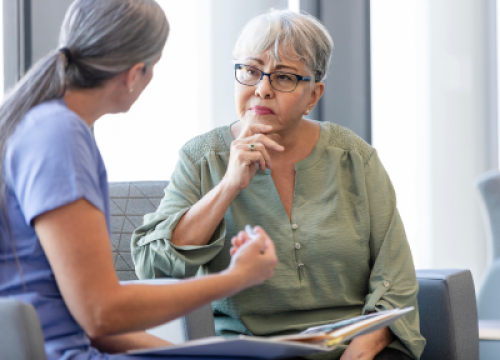Parkinson’s 101: We Answer Your Top Parkinson’s Questions

Nearly one million Americans are living with Parkinson’s disease (PD). With Parkinson’s, the earlier you detect the disease and receive a diagnosis, the sooner you can begin living a better quality of life. Below we answer your top Parkinson’s questions:
1. What is Parkinson’s?
Parkinson's disease is a neurodegenerative disorder that affects predominately dopamine-producing (“dopaminergic”) neurons in a specific area of the brain called substantia nigra. Symptoms generally develop slowly over years. Although there is no cure, treatment options vary and are tailored to each person’s individual symptoms.
Learn more: What Is Parkinson’s
2. What are the early signs of Parkinson’s?
There are 10 early signs of Parkinson's. No single one of these signs means that you should worry, but if you have more than one, consider speaking with your doctor. Early signs include:
- Tremor: A slight shaking or tremor in your finger, thumb, hand or chin.
- Small Handwriting: A change in handwriting, such as smaller letter sizes and crowding words together — this is called micrographia.
- Loss of Smell: More trouble smelling foods like bananas, dill pickles or licorice.
- Trouble Sleeping: Thrashing around in bed or acting out dreams when you are deeply asleep.
- Trouble Moving or Walking: Stiffness in your body, arms or legs; arms don’t swing when you walk.
Read all the early signs of Parkinson’s: 10 Early Signs of Parkinson's Disease
3. What are the stages of Parkinson’s?
There are typical patterns of progression in Parkinson’s defined in stages.
Stage One: Initial stage where mild symptoms generally do not interfere with daily activities. Tremor and other movement symptoms occur on one side of the body only. Changes in posture, walking and facial expressions can occur.
Stage Two: Symptoms start getting worse. Tremor, rigidity and other movement symptoms affect both sides of the body. Walking problems and poor posture may be apparent. Daily tasks are more difficult and lengthy.
Stage Three: Considered mid-stage, loss of balance, slowness of movements and falls become more common. The person is still fully independent, but symptoms significantly impair activities such as dressing and eating.
Read all the stages of Parkinson’s: Stages of Parkinson’s
4. What are the symptoms of Parkinson’s?
Parkinson’s is called a movement disorder because of the tremors, slowing and stiffening movements it can cause — known as movement symptoms. Continue reading for more types of movement symptoms.
Most people develop other symptoms related to Parkinson's that are collectively known as non-motor symptoms. They can include anxiety, depression, sleep disorders and weight management issues.
Read more about Movement Symptoms and Non-Movement Symptoms.
5. Is vertigo a sign or symptoms of Parkinson’s?
Yes. Vertigo and dizziness are commonly reported symptoms in people with Parkinson’s. Most experts agree that dizziness and vertigo can be broadly defined as the sensation of spinning or whirling, and the sensation can be associated with balance problems.
Read more about Vertigo and Dizziness.
6. Is Parkinson’s genetic?
We do not know exactly what causes Parkinson's, but scientists believe that a combination of genetic and environmental factors are the cause. Genetics cause about 10% to 15% of all Parkinson's.
Understanding the connection between Parkinson's and genetics can help us understand how the disease develops and ultimately how it can be treated or cured. This is why studies like the Parkinson's Foundation PD GENEration study that is linking genetics to Parkinson's are essential.
- Read more about Genetics and Parkinson’s.
- Enroll for PD GENEration.
We are here for you. Call the Parkinson's Foundation Helpline 1.800.4PD.INFO (1-800-473-4636) for answers to your Parkinson’s questions.
Related Blog Posts


